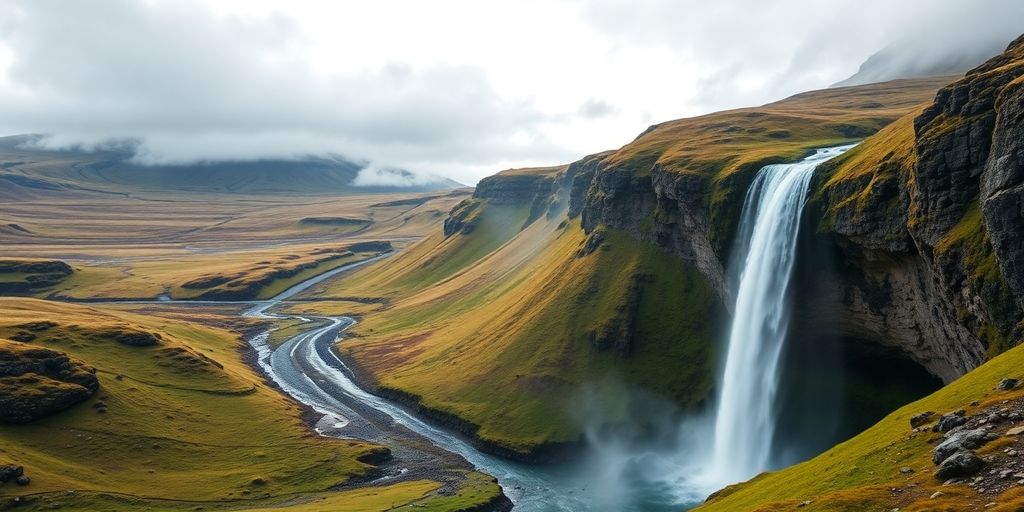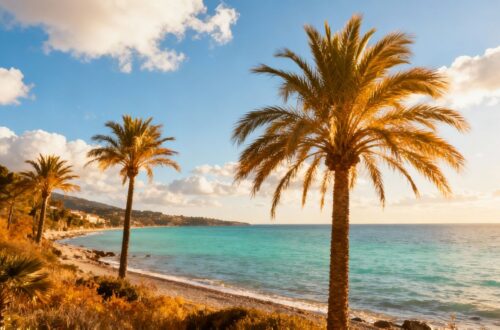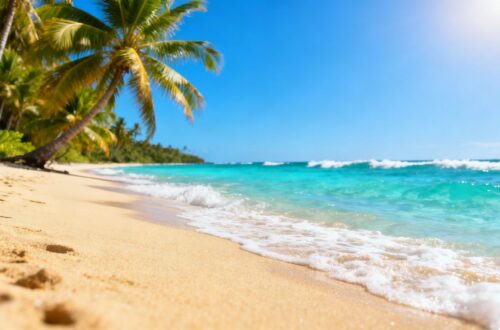As 2025 approaches, you might be thinking about your next big adventure. If you love nature and unique landscapes, Iceland should definitely be on your radar. This island nation, known as the Land of Fire and Ice, offers some truly breathtaking sights that are perfect for anyone who enjoys the great outdoors. We’ve put together a list of the Top 5 Places to Visit in Iceland for Nature Lovers, so you can start planning an unforgettable trip.
Key Takeaways
- Thingvellir National Park: See where tectonic plates meet.
- Jökulsárlón Glacier Lagoon: Marvel at floating icebergs.
- Goðafoss Waterfall: Witness the “Waterfall of the Gods.”
- Laugavegur Trail: Experience a multi-day hike through diverse terrain.
- Landmannalaugar: Explore colorful rhyolite mountains and hot springs.
1. Thingvellir National Park
Thingvellir National Park is a pretty unique spot, and not just because it’s a UNESCO World Heritage Site. It’s literally where the North American and Eurasian tectonic plates are pulling apart. You can actually see the rift valley, with all these fissures and canyons that have formed over time. Some of these cracks are filled with super clear water, and you can even go snorkeling or diving between the continents if you’re feeling adventurous. It’s a wild geological display, for sure.
But it’s not just about the rocks and the earth splitting. Thingvellir has a huge place in Icelandic history too. This is where the Althingi, Iceland’s parliament, first met way back in 930 AD. Imagine, people gathering here for centuries to make laws and sort things out. It was a real hub for farmers, traders, and all sorts of folks.
Geological Wonders
- Walk through the Almannagjá gorge, a massive canyon marking the edge of the North American plate.
- See the Öxarárfoss waterfall, which tumbles over the edge of the rift.
- Explore the Silfra fissure, famous for its incredibly clear glacial water, perfect for diving and snorkeling.
Historical Significance
- Visit Lögberg (Law Rock), where laws were traditionally proclaimed.
- Understand the site’s importance as the meeting place of the ancient Icelandic parliament, the Althingi.
- Reflect on the centuries of history that unfolded in this dramatic landscape.
Thingvellir offers a powerful connection to both the raw forces of nature and the deep roots of Icelandic culture. It’s a place where you can stand between continents and walk in the footsteps of history.
2. Jökulsárlón Glacier Lagoon
Okay, so imagine this: a massive glacial lake in southeastern Iceland, way bigger than you might expect, and it’s absolutely packed with icebergs. That’s Jökulsárlón Glacier Lagoon for you. It’s not really a lagoon, more like a lake, and it’s the deepest one in the whole country. What makes it so special, though, are these huge chunks of ice that have broken off the nearby glacier. They just float around, looking all majestic and blue, and they move pretty slowly, so you get a good amount of time to just stare.
Exploring the Icebergs
- Boat Tours: You can actually get out on the water in these special amphibious vehicles. They take you right up close to the icebergs, which is pretty cool. You’ll see ice in all sorts of shapes and sizes, some really massive. It’s a great way to get a feel for the scale of it all.
- Zodiac Boats: If you want something a bit more adventurous, there are smaller zodiac boats. These can get into tighter spots and you feel even closer to the ice. Just make sure you dress warm, because you’re going to get splashed!
- Shoreline Views: Even if you don’t go on a boat, the views from the shore are still amazing. You can walk along the black sand beach and see the icebergs that have washed up. It’s a really unique sight.
Diamond Beach
Right across the road from the lagoon, you’ll find Diamond Beach. This is where smaller pieces of ice from the lagoon wash out to sea and then get tossed back onto the black sand. They look like giant diamonds scattered everywhere, especially when the sun hits them. It’s a photographer’s dream, honestly.
Wildlife Spotting
Keep an eye out for seals! They love hanging out in the lagoon, swimming around the icebergs and sometimes popping their heads up to say hello. It’s always a treat to see them in their natural habitat.
The sheer size of the icebergs and the constant, slow movement of the water create a really peaceful yet powerful atmosphere. It’s the kind of place that makes you feel small in the best way possible.
3. Goðafoss Waterfall
You can’t really talk about Iceland’s waterfalls without mentioning Goðafoss. It’s often called the "Waterfall of the Gods," and honestly, the name fits. It’s not the biggest or the most powerful, but there’s something really special about its horseshoe shape.
The water cascades over a wide, curved ledge, creating this beautiful, almost gentle curtain of water. It’s a really pretty sight, especially when the sun hits it just right. You can get pretty close to it, and the spray is refreshing on a warmer day. It’s located in the north of Iceland, not too far from Lake Mývatn, which is another great area to explore.
Here are a few things to know before you go:
- Getting there: It’s easily accessible from the Ring Road, so you don’t need a special vehicle.
- Best time to visit: Summer offers the best light and access, but in winter, it can freeze over, which is a totally different, but equally stunning, experience.
- What to do: Walk around the viewing platforms on both sides of the falls to get different perspectives. There’s a small cafe nearby if you need a break.
People say that in 1000 AD, when Iceland officially adopted Christianity, the pagan lawspeaker Thorgeir Ljosvetningagodi threw his statues of the Norse gods into this waterfall. That’s where the name comes from. It’s a pretty cool bit of history tied to the place.
It’s a place that feels both grand and intimate at the same time. Definitely a must-see if you’re exploring the northern part of the island.
4. Laugavegur Trail

If you’re looking for a real challenge and a chance to see Iceland’s heart, the Laugavegur Trail is it. This trek is about 34 miles long and usually takes about four to five days to complete. You start near Landmannalaugar, which is famous for its hot springs, and end up in Þórsmörk, a beautiful valley. Along the way, you’ll walk through some pretty wild landscapes – think colorful mountains, black sand deserts, and even some lava fields with steam coming out of the ground. It’s a serious hike, not for the faint of heart, but the views are absolutely incredible.
Planning Your Hike
Getting ready for Laugavegur takes some thought. You don’t need a special permit, but you absolutely have to book your spots in the mountain huts well ahead of time, especially if you’re planning to go during the busy months of June, July, August, or September. Lots of people hike this trail, so booking early is key.
- Duration: Typically 4-5 days, but can be extended.
- Distance: Approximately 34 miles (55 km).
- Difficulty: Challenging, requires good physical condition.
- Best Time to Go: Summer months (June-September) for better weather and accessibility.
The trail offers a unique journey through Iceland’s diverse geology, from geothermal areas to glacial valleys. It’s a chance to truly disconnect and immerse yourself in nature’s raw power.
5. Landmannalaugar
Landmannalaugar is a real gem tucked away in Iceland’s Southern Highlands. It’s famous for its incredible hot springs, which are totally free to use. Imagine soaking in warm water, with temperatures around 97-104°F (36-40°C), surrounded by the rugged landscape near the Torfajökull volcano and green fields. It’s quite the spot.
But it’s not just about the hot springs. Landmannalaugar is also the starting point for the famous Laugavegur Trail, a multi-day hike. The area is known for its colorful rhyolite mountains. These mountains show off shades of pink, yellow, ochre, and purple, all thanks to the geothermal activity happening below. It’s a visual treat.
Getting There
Because it’s so remote, you’ll likely need a 4×4 vehicle to reach Landmannalaugar. The journey itself is part of the adventure, taking you through some of Iceland’s wilder terrain.
What to Do
- Soak in the natural hot springs: This is a must-do. The pools are naturally heated and offer a relaxing experience.
- Hike the Laugavegur Trail: Even if you don’t do the whole thing, day hikes from Landmannalaugar offer stunning views of the colorful mountains.
- Explore the Rhyolite Mountains: Take time to appreciate the unique geology and vibrant colors of the landscape.
- Stargaze: The lack of light pollution means this is a fantastic place to see the night sky, and if you’re lucky, the Northern Lights.
The remoteness of Landmannalaugar means you can really disconnect and immerse yourself in nature. It’s a place where the earth feels alive with geothermal energy and the landscapes are unlike anywhere else.
6. Thorsmork
Thorsmork, or Thor’s Valley, is a mountain ridge nestled between three glaciers: Eyjafjallajökull, Mýrdalsjökull, and Tindfjallajökull. Getting here is part of the adventure, usually requiring a sturdy 4×4 vehicle to cross the glacial rivers. Once you arrive, you’re greeted by a landscape that feels almost otherworldly. Think lush green valleys, dramatic canyons, and the constant, awe-inspiring presence of ice.
Hiking Trails
Thorsmork is a hiker’s paradise, offering trails for all levels. The most famous is the Laugavegur Trail, which ends here, but there are plenty of day hikes too.
- Valahnukur: A relatively short but steep hike offering panoramic views of the entire valley.
- Basseur: A more challenging climb that rewards you with stunning vistas of the surrounding glaciers.
- The Golden Circle Extension: Some trails connect to nearby areas, allowing for longer, multi-day treks.
Unique Flora and Fauna
What’s really cool about Thorsmork is its surprisingly rich vegetation, especially considering its glacial surroundings. You’ll find birch forests and a variety of wildflowers clinging to the slopes. Keep an eye out for arctic foxes; they’re shy but sometimes spotted darting through the undergrowth.
Glacial Views
Being surrounded by glaciers means you get some incredible perspectives. You can often see the ice caps looming in the distance, and some trails even take you close enough to hear the ice crackle. It’s a stark reminder of Iceland’s raw, natural power.
The sheer scale of the landscape here is hard to grasp until you’re actually in it. The air feels cleaner, and the silence, broken only by the wind or a distant river, is profound. It’s a place that really makes you feel small in the best possible way.
7. Dalvík

Dalvík is a charming fishing town nestled in the north of Iceland, specifically in the stunning Eyjafjörður fjord. It’s a fantastic spot for anyone who loves the ocean and wants to experience a more authentic slice of Icelandic life away from the biggest crowds. The town itself is quite picturesque, with colorful houses and a backdrop of dramatic mountains. It’s the kind of place where you can really feel the rhythm of coastal living.
Whale Watching Capital
Dalvík is often called the "Whale Watching Capital of Iceland," and for good reason. The waters around the town are teeming with marine life, especially during the summer months. Humpback whales, minke whales, and even the occasional blue whale are frequently spotted here. The tours are usually run by local fishermen who know these waters like the back of their hand, making for a really genuine experience. It’s not uncommon to see multiple whales on a single trip, and the sheer size of these creatures is something you won’t forget.
Arctic Char Fishing
If you’re into fishing, Dalvík offers some excellent opportunities, particularly for Arctic char. The rivers and fjords in the area are known for their healthy populations of this delicious fish. You can arrange guided fishing trips that take you to prime spots. It’s a peaceful way to spend an afternoon, surrounded by incredible scenery. Even if you don’t catch anything, the experience of being out on the water is rewarding.
Local Culture and Cuisine
Beyond the natural attractions, Dalvík has a friendly local vibe. You can explore the small harbor, visit the local swimming pool (a must-do in Iceland!), or try some of the fresh seafood. The town has a few good restaurants where you can sample the catch of the day, often featuring delicious fish like cod or haddock, and of course, Arctic char. It’s a great place to get a taste of real Icelandic food.
Getting There
Dalvík is located about a 45-minute drive from Akureyri, the "Capital of the North." If you’re flying into Akureyri Airport, renting a car is the easiest way to reach Dalvík. The drive itself is scenic, winding along the fjord. It’s a bit of a journey from Reykjavik, but definitely worth it if you’re looking for a less-traveled, yet incredibly rewarding, part of Iceland.
8. Blue Lagoon
Okay, so the Blue Lagoon. It’s probably the most famous spot in Iceland, and for good reason. It’s this big geothermal spa, and the water is this crazy milky blue color you just don’t see anywhere else. It’s actually man-made, starting in the 70s from water run-off from a nearby geothermal power plant. Pretty wild, right?
The Science Behind the Blue
So, what makes the water that unique color? It’s all about the silica. These tiny silica particles suspended in the water reflect sunlight, making it look blue. It’s kind of an optical illusion, really. The color can even change depending on the weather and time of day, sometimes looking more grey or even turquoise. The water itself is packed with minerals and good bacteria, and they even give you silica masks to use. People say it’s great for skin conditions like psoriasis, and some even claim it helps with arthritis. It’s heated naturally, with pools averaging between 85°F and 102°F (30°C to 39°C).
Location and Planning Your Visit
The Blue Lagoon is super convenient to get to. It’s only about 14 miles (22 kilometers) from Keflavik International Airport and 31 miles (49 kilometers) from downtown Reykjavik. You can easily find affordable transfers from the airport.
Because it’s so popular, you really need to book your tickets in advance. Seriously, don’t just show up expecting to get in. It’s a top-rated attraction, so planning ahead is key.
What to Expect
Beyond the main pools, the complex has saunas and steam rooms too, which are pretty nice for relaxing. They also offer special treatments like in-water massages and beauty treatments using local algae and minerals. The whole place is set in the Reykjanes Peninsula, which has these really cool, almost otherworldly lava fields covered in moss, especially when you see it through the steam. It’s a great place to unwind either at the start or end of your trip.
9. Langjökull Glacier
Langjökull, meaning "Long Glacier," is Iceland’s second-largest ice cap, and it’s a pretty impressive sight. It’s not just a big chunk of ice, though; it’s a dynamic landscape that offers a lot for anyone interested in Iceland’s natural wonders. Think vast, white expanses stretching out as far as you can see, with some areas reaching depths of nearly 2,000 feet of ice and snow. It’s a place where you can really feel the scale of nature.
What’s really neat about Langjökull is that you can actually go inside it. There’s a man-made ice tunnel that lets you walk through the heart of the glacier, which is a pretty unique experience. You get to see the layers of ice up close, and it’s a stark reminder of how glaciers form and change over time. It’s not something you see every day, that’s for sure.
Activities on Langjökull
- Glacier Hiking: Strap on some crampons and explore the surface of the glacier with a guide. It’s a fantastic way to get a feel for the ice.
- Ice Caving: During certain times of the year, natural ice caves form, offering stunning blue ice formations.
- Snowmobiling: For a bit more speed, you can take a snowmobile tour across the vast ice fields.
- Ice Tunnel Tours: As mentioned, walking through the man-made tunnel is a must-do for many visitors.
What to Expect
When you visit Langjökull, especially for activities like hiking or snowmobiling, you’ll want to be prepared for the weather. It can change quickly, so dressing in layers is key. Most tours provide necessary gear like crampons or snowmobile suits, but it’s always good to check beforehand. The sheer size of the glacier means you’ll likely be in a remote area, so it’s best to go with a guided tour for safety and to make the most of your visit.
Visiting Langjökull is a chance to connect with Iceland’s icy heart. It’s a place that feels ancient and powerful, and the experiences you can have there, from walking inside the ice to traversing its surface, are truly memorable. It’s definitely worth the trip if you’re looking for something a bit different.
10. Skaftafell
Skaftafell is a real gem, tucked away as part of Vatnajökull National Park. It used to be its own park, which makes sense because the scenery here is just wild. You get these amazing green birch forests right next to these stark, black desert landscapes and old lava fields. It’s pretty wild how much variety is packed into one place.
What’s really cool is that all the glacier tongues and lagoons you see here start from Vatnajökull, which is Europe’s biggest glacier. If you’re into glaciers, this is definitely the spot. You can actually go on glacier hikes from here, which is pretty awesome. They say it’s one of the best places in Iceland for anyone who loves the outdoors.
Glacier Hiking Tours
If you want to get up close with a glacier, Skaftafell is a prime starting point. Several companies offer guided tours that take you onto the ice. These tours usually last a few hours and come with all the gear you need, like crampons and ice axes. It’s a great way to experience the ice safely.
Hiking Trails
There are also plenty of hiking trails for all levels. Some are short walks to viewpoints, while others are longer treks. A popular one leads to Svartifoss, a waterfall famous for its black basalt columns. It’s a bit of a walk, but totally worth it for the view.
What to Expect
- Scenery: Expect a mix of glaciers, waterfalls, forests, and volcanic landscapes.
- Activities: Glacier hiking, ice climbing, and various hiking trails are available.
- Accessibility: It’s a popular stop, especially for those doing the Ring Road.
Skaftafell really shows off Iceland’s diverse natural beauty. It’s a place where you can feel the raw power of the glaciers and see how they shape the land. Definitely a must-visit for any nature enthusiast.
Your Icelandic Adventure Awaits
So, there you have it – five incredible spots in Iceland that are just begging to be explored by nature lovers in 2025. From the dramatic landscapes of Thingvellir to the icy wonders of Jökulsárlón, this island nation truly offers something special. Whether you’re planning a long hike or just want to soak in the views, Iceland is ready to impress. Pack your bags, get ready for some amazing sights, and make 2025 the year you experience the raw beauty of Iceland firsthand. You won’t regret it.
Frequently Asked Questions
Why is Iceland a great place for people who love nature?
Iceland is amazing for nature lovers because it has so many different kinds of cool natural sights! You can see huge glaciers, powerful waterfalls, bubbling hot springs, and even places where the land is pulling apart. It’s like a whole world of natural wonders packed into one country.
Can I see puffins in Iceland?
Yes, you can see puffins in Iceland, especially during the summer months. They like to build nests on cliffs and islands along the coast. It’s a really popular activity to go and watch these cute birds!
When is the best time to visit Iceland for nature?
The best time to visit depends on what you want to see. For the Northern Lights and a magical winter wonderland, go between September and April. If you want to experience the midnight sun and see puffins, summer (June to August) is the time to go.
What are some famous waterfalls in Iceland?
Iceland is known for its stunning waterfalls! Some of the most famous ones are Gullfoss, Skógafoss, and Seljalandsfoss. Each one is beautiful in its own way, offering different views and experiences.
Are there good hiking trails in Iceland?
Absolutely! Iceland offers incredible opportunities for hiking. Trails like the Laugavegur Trail take you through amazing landscapes of mountains, glaciers, and colorful hot springs. There are trails for all levels, from easy walks to challenging multi-day treks.
Can I experience hot springs or geothermal pools in Iceland?
Yes, Iceland has many geothermal areas. You can relax in famous spots like the Blue Lagoon, which has warm, mineral-rich waters. There are also many natural hot springs scattered throughout the country, often in beautiful, scenic locations.






